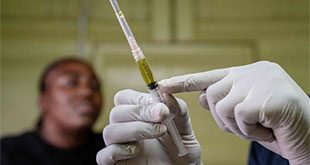
Images of Museveni dishing out army ration biscuits and wads of cash to desperate elderly citizens kneeling before him appeared to portray how far Museveni has shifted from his Marxist revolutionary ideas of 40 years ago to embrace the neo patrimonialism that he was opposed to.
Big numbers
Where critics say the party has failed on fighting corruption and effective governance, the NRM has maintained an unassailable lead in party numbers. The NRM enjoys a vast majority in parliament and uses caucus as the de facto parliament.
Party leaders say the big numbers are an immense advantage during election time. In a previous interview, Richard Todwong, the Deputy Secretary General of NRM, said the party’s big numbers are proof of NRM’s invincibility and is happy that the growing trend is unlikely to be reversed soon.
“This country has 40 million people of whom 16.5 million are registered voters. Of those 16 million, 13 million are NRM voters. So we have three quarters of the national register,” Todwong said.
Todwong said 75% of the LC members at LC 3 and LC5 level are NRM in addition to the 13 million voters who he said are NRM supporters on the national register. In 2018, the NRM won 69% of the LC 1 elections, independents (most allied to NRM) took 22% and the combined opposition had a measly 9%. Of the 66 Independent MPs, 44 are allied to the NRM.
Today, when a candidate stands for an election on the NRM ticket, they have an almost guaranteed chance of winning.
One could argue that had the lifting of the presidential age limit been subjected to a referendum in 2017, Museveni would not have had his way given how unpopular the amendment was across the country. As the MPs received threats in their constituencies, they found refuge in the House where NRM invoked its numerical strength to amend the constitution to remove the age limit.
Security, once a forte of the NRM, has been a nightmare in the last four years. President Museveni’s solution has been the rushed recruitment of youth aged between 18 and 30 as Local Defence Units (LDUs) as a counter measure to the rampant killings and violent crime in Kampala and areas of Greater Masaka.
Experts said the LDUs were a risk factor themselves given that Museveni publicly said they would only be paid for a few months, among other factors. There were fears over armed LDUs roaming the streets at night penniless. This is in addition to the already deactivated crime preventers who had a modicum of military training when they were under the police during the reign of former Inspector General of Police (IGP) Gen. Kale Kayihura.
After he fired Kayihura in early 2018, Museveni has continued to lambast the police for using outmoded methods of policing seemingly oblivious of the fact that he is Commander in Chief.
While addressing the 25th Police Council at police headquarters in November, Museveni, ironically said the police should adopt a colonial era model for managing crime “because the colonialists didn’t have enough resources, their plan was through the chiefs – Muluka and sub-county chiefs.”
“They (chiefs) would call the tenda (police patrol). I closely monitored it between 1951 and 1958. I could see these people manage huge areas using a skeleton number of police officers,” Museveni said in response to IGP Okoth Ochola who requested the President for more personnel.
As he has grown older and geared towards political survival, Museveni’s hand on managing security and policing appears to have weakened. As the murders of high profile individuals and kidnaps took a toll on the nation, Museveni has gambled from one strategy to another. First was addressing parliament and even recommending banning the wearing of hoods in urban areas. The next was a decision that appeared to be buck passing. In October 2019, Museveni tasked Sabiiti Muzeyi, the deputy IGP, to come up with a plan to fight urban crime in a mere two days.
On the question of whether NRM is beyond redemption? Crispin Kaheru, a civil society activist, asks “Redemption form what and to what?” He tells The Independent “Maybe the NRM has served its purpose and is continuing to, according to its creator and vision bearer.”
Kaheru says “It is still delivering on that as we shall confirm when its top organs meet this week.” He asks, “Were the current functionaries ever a part of it from start? What’s their claim?”
The functionaries Kaheru may have been referring to include Justine Lumumba who as secretary general is a high ranking member of the NRM in spite of being virtually unknown a decade ago. She replaced former prime minister and secretary general, Amama Mbabazi.
But, as the party marks 34 years in power, Mbabazi could be coming back to play an outsize role in his former party. Mbabazi fell out with Museveni in 2014 and was sacked from both positions that year. The two comrades have maintained contact since their fall out and have been seen in jovial moments in public.
The two have worked together for a period close to fifty years since Museveni formed Front for National Salvation (FRONASA) in 1971. Photos of Mbabazi and Museveni together that circulated on New Years’ Eve sparked the rumours of the reunion.
In an interview with The Independent, former minister and former guerilla in the NRA, Jim Muhwezi, likened the NRM to a tree that sheds its leaves.
“Others fall off and others grow, for example, some people disagreed on term limits and they left,” he said.
Faced with increasing corruption, incidents of abuse of power and insecurity, the NRM party perhaps needs to be focusing less on its leaves which fall and re-grow and more on its roots, which are the pledges it made when it captured power.
****
 The Independent Uganda: You get the Truth we Pay the Price
The Independent Uganda: You get the Truth we Pay the Price





